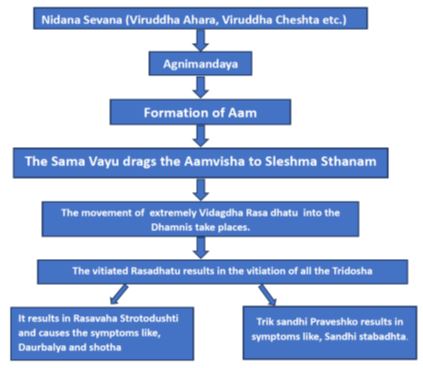Nidanapanchakatmak study of Aamvata
DOI:
https://doi.org/10.21760/jaims.8.4.7Keywords:
Aamvata, NidanapanchakaAbstract
In Ayurveda there are various approaches to diagnose a disease; the concept of Nidan Panchak is one such modality of Ayurveda. Nidan Panchak helps to diagnose diseases at various stages. Knowing the definite Nidana (etiological factors), Dosha vitiation, Samprapti (pathogenesis or progress of disease) and to check it at early stage is given prime importance. Nidan Panchaka plays vital role to identify types of disease. It consists of five subtypes which are Nidan (causes), Purvarupa (Prodromal Features), Rupa (Clinical features), Upashaya (Therapeutic methods), and Samprapti (Pathogenesis). These five elements collectively or selectively help in making an accurate diagnosis. Aamvata is a diseased caused by Dushti of Rasavaha Strotas in which there is formation of Ama due to Jatharagni Mandya. The Aamvata condition closely resembles with Rheumatoid arthritis, an autoimmune inflammatory condition characterised by symmetrical polyarthritis. Aamvata disease was first described in Laghutrayee by Acharya Madhava. Before the Acharya Madhava the concept of Aamvata was vague. Aamvata develops due to Dushti or Prakopa of Ama as well as Vata Dosha. As the disease Aamvata is very prevalent in society, it’s important to know the exact diagnosis along with treatment. In our current review we had tried to elaborate about the Nidanapanchaka of Aamvata.
Downloads
References
Sapra Umesh Kumar et al: Clinical Importance Of Nidana Panchaka – A Review. International Ayurvedic Medical Journal {online} 2019 {cited February, 2019} Available from: http://www.iamj.in/posts/images/upload/243_248.pdf
Dr. Suraj M. Patil, and Dr. M. V. Mokashi. (2017). “AMAVATA: REVIEW OF LITERATURE.” International Journal of Research - Granthaalayah, 5(12), 128-134. https://doi.org/10.5281/zenodo.1133822.
Ayurvedic Guidelines for Amavata (Rheumatoid Arthritis ) Central Council for research in Ayurvedic sciences. http://www.ccras.nic.in/content/ayurvedic-guidelines-amavata-rheumatoid-arthritis
Madhava Nidanam with the sanskrit commentary, Madhukosha by vijayrakshit & srikant dutta volume 1. Revised edition 2003, Mad.Nidana 25/ 1Chaukhambha Sansthan Varanasi
Madhava Nidanam with the sanskrit commentary, Madhukosha by vijayrakshit & srikant dutta volume 1. Revised edition 2003, Mad.Nidana 25/ 2-5 Chaukhambha Santhan Varanasi
Nisha et al: A Review Article on Amavata W.S.R. Rheumatoid Arthritis. International Ayurvedic Medical Journal {online} 2019 {cited December, 2019} Available from: http://www.iamj.in/posts/images/upload/2261_2267.
Nehaa Srinivasan, Girish KJ, Sunil Sabasannavar Jinnappa, Vibhu Sudhakar Powar. A clinical study on the combined effectiveness of Pathyadi Churna and Kshara Basti in Amavata (Rheumatoid Arthritis). J Ayurveda Integr Med Sci 2022;10:29-39. http://dx.doi.org/10.21760/jaims.7.10.5
A thesis work by Dr. Shweta Pandey on Amavata wrs rheumatoid arthritis with Shiva Guggulu and Simhnad Guggulu-2011-KC-GAAC, Ahmedabad, gau, Jamnagar
A thesis work by Dr. Laxmeshwar Mandal on Nirgundipatra swarasa, Trayodashanga guggulu-AmavataKC-2004, IPGT&R, Jamnagar, Gujrat.















